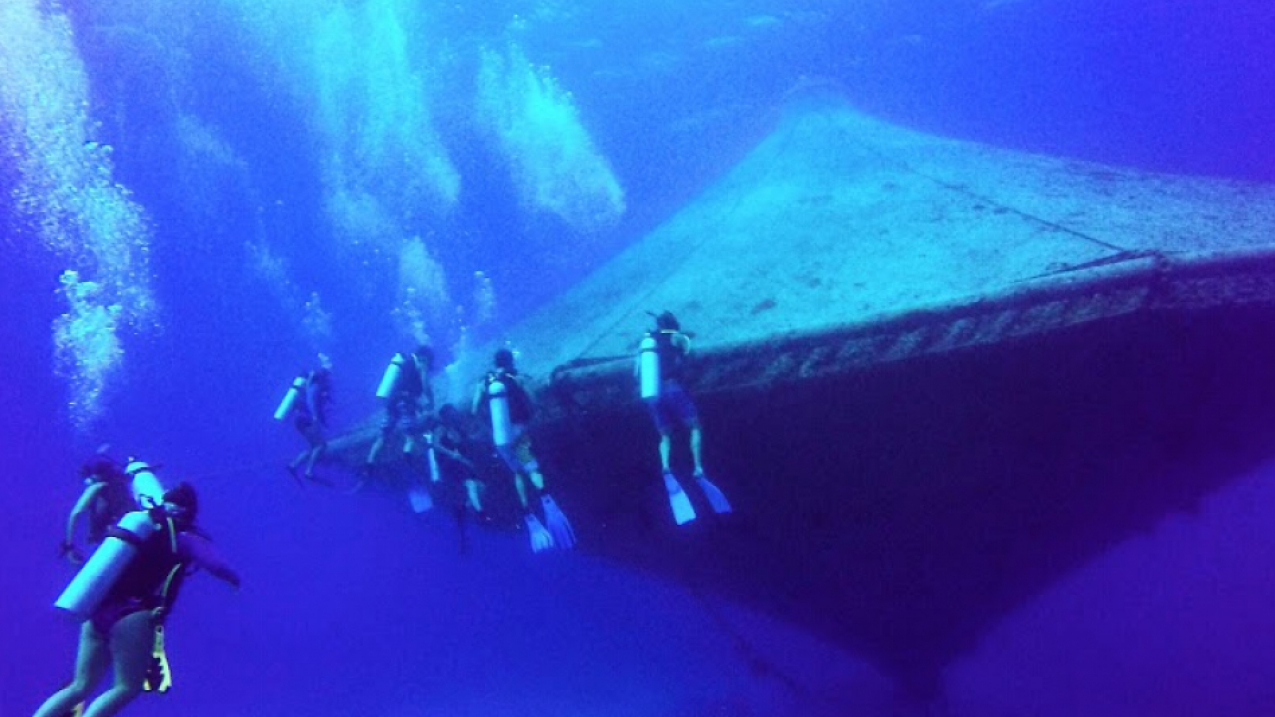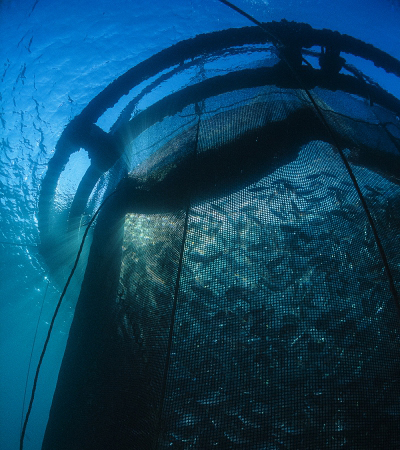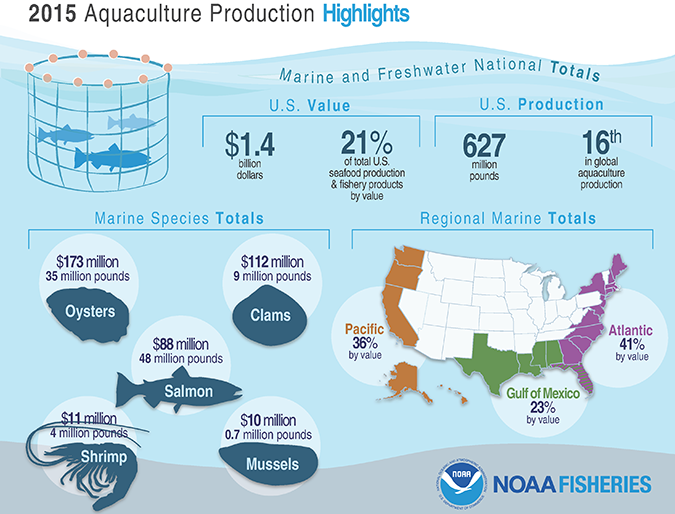
Divers around the open-ocean aquaculture cage at the Cape Eleuthera Institiute in The Bahamas. These cages are not currently used in the Gulf, but represent one type of farming technology that could work in in the region. (Image credit: Courtesy of Kelly Martin)
Aquaculture: Bringing American-farmed seafood to your plate
What is aquaculture?
Economic benefits
Health & environmental benefits
Aquaculture around the world
More on aquaculture
Aquaculture is a type of farming: It’s the breeding, rearing and harvesting of plants and animals in the water for any commercial, recreation or conservation purpose.
Methods of aquaculture production
Researchers and aquaculture producers grow both freshwater and marine species. Aquaculture includes seafood production from hatchery fish and shellfish grown to market size in cages, ponds and tanks. Many farmed fish and shellfish begin life in a hatchery — where fish eggs are hatched and young fish are raised — and farmers transfer them to ocean cages or net pens as they grow.
Popular marine aquaculture species include:
-
oysters;
-
clams;
-
mussels;
-
shrimp; and
-
salmon.
Seafood farmers also produce lesser amounts of cod, moi, yellowtail, barramundi, seabass, seabream and seaweed.
In another form of aquaculture known as stock restoration, experts grow fish and shellfish in a hatchery before releasing them to rebuild wild populations or coastal habitats, such as oyster reefs.
Aquaculture also includes production of ornamental fish for the aquarium trade, as well as growing plant species used in a range of food, biofuels, pharmaceutical, nutritional and biotechnology products.
Aquaculture presents an opportunity to reduce America’s reliance on imported seafood, increase our nation’s food security and create jobs.
The United States includes the world’s second largest Exclusive Economic Zone — the coastal waters and seabed to which a nation claims exclusive rights. Yet, the U.S. imports the vast majority of our seafood. In 2017, America’s commercial seafood trade deficit rose to $15.8 billion, with aquaculture accounting for roughly half of those imports.
$15.8 billion
America’s commercial seafood trade deficit. Growing our own seafood provides the nation with an opportunity to reduce our reliance on other countries and create jobs in the U.S.
Even if we consumed all of what we catch and grow, the U.S. would remain about 1 million metric tons short of fulfilling our current domestic demand for seafood. And, this demand is only going to rise as our population continues to grow.
Here’s the good news: Aquaculture is already an important economic driver in some U.S. economies.
But there is significant untapped potential to sustainably expand domestic aquaculture. We can grow a lot of seafood in a small amount of space. New and expanded seafood farming operations in an area the size of Washington D.C. (less than 1/1000th of a percent of U.S. waters) could produce an additional $6 billion of seafood.
In addition to reducing the seafood trade deficit, these farms could generate tens of thousands of new jobs on America’s working waterfronts. From employing off-season fishermen to installing new ice houses and processors, expanding domestic aquaculture can play a critical role in providing economic stability to our fishing communities.
Seafood is a low-calorie source of protein rich in heart-healthy omega-3 fatty acids, vitamins and minerals. The U.S. departments of Health and Human Services and Agriculture jointly publish federal guidelines that recommend Americans nearly double their seafood consumption. Seafood farming is also one of the most environmentally sustainable ways of producing protein on the planet.
Fish leave a smaller carbon footprint than other popular protein sources and require less feed input per pound produced. Plus, expanding farmed fisheries, as a complement to wild harvesting is one way to help satisfy the consumer demand for “locally grown” food.

Seafood farming technology has come a long way in the past 20 to 30 years. Growing options in fish feed, for example, mean farmed fish — even carnivorous ones — can eat a mostly vegetarian diet while still absorbing the necessary nutrients to grow and thrive. Antibiotic use is nearly non-existent in U.S. seafood farms these days. Equipment improvements mean farmed fish escape ocean pens less often; escapes are rare, and the risk of disease transmission from farmed fish to wild species is low.
We can also selectively use aquaculture to help restore struggling species and habitats. Farmed shellfish and seaweed can even improve the water quality around them by filtering water and removing excess nitrogen.
Global market trends have underscored the need to increase U.S. marine fish farming.
Worldwide demand for seafood is growing fast. Projections clearly show a future gap in global seafood supply, and other countries are investing in aquaculture. The U.S. ranks 16th in total aquaculture production — far behind China, Indonesia, and India. To change that, NOAA Fisheries developed a strategy to increase production in U.S. waters.

At home and abroad, NOAA is working to help American businesses farm more seafood here and reap more economic benefits for the nation. NOAA plays a big role in aquaculture, from supporting cutting-edge science and research to federal policymaking, industry permitting and regulation. The agency fosters safe seafood production, creates jobs and increases business opportunities in coastal communities. Aquaculture complements NOAA’s overall mission to maintain healthy, productive marine populations, ecosystems and coastal communities.
We have roughly three decades of best practices to use for today’s aquaculture efforts. And NOAA intends to continue to foster sustainable methods for aquaculture for a growing industry and future generations.
NOAA is working to turn America’s longstanding commercial seafood trade deficit around. Our mission is to ensure more seafood is “Made in America” and the nation’s proud working waterfront heritage is passed on to the next generation of farmers working with the water.
To learn more about U.S. aquaculture, please see the following feature stories and websites:
South Carolina oyster farming: One man finds success on the half shell
Blog: Single millennial or family of four, fish is what’s for dinner
NOAA Fisheries Office of Aquaculture
NOAA Oceans - aquaculture siting
Aquaculture is a type of farming: It’s the breeding, rearing and harvesting of plants and animals in the water for any commercial, recreation or conservation purpose.
Methods of aquaculture production
Researchers and aquaculture producers grow both freshwater and marine species. Aquaculture includes seafood production from hatchery fish and shellfish grown to market size in cages, ponds and tanks. Many farmed fish and shellfish begin life in a hatchery — where fish eggs are hatched and young fish are raised — and farmers transfer them to ocean cages or net pens as they grow.
Popular marine aquaculture species include:
-
oysters;
-
clams;
-
mussels;
-
shrimp; and
-
salmon.
Seafood farmers also produce lesser amounts of cod, moi, yellowtail, barramundi, seabass, seabream and seaweed.
In another form of aquaculture known as stock restoration, experts grow fish and shellfish in a hatchery before releasing them to rebuild wild populations or coastal habitats, such as oyster reefs.
Aquaculture also includes production of ornamental fish for the aquarium trade, as well as growing plant species used in a range of food, biofuels, pharmaceutical, nutritional and biotechnology products.
Aquaculture presents an opportunity to reduce America’s reliance on imported seafood, increase our nation’s food security and create jobs.
The United States includes the world’s second largest Exclusive Economic Zone — the coastal waters and seabed to which a nation claims exclusive rights. Yet, the U.S. imports the vast majority of our seafood. In 2017, America’s commercial seafood trade deficit rose to $15.8 billion, with aquaculture accounting for roughly half of those imports.
$15.8 billion
America’s commercial seafood trade deficit. Growing our own seafood provides the nation with an opportunity to reduce our reliance on other countries and create jobs in the U.S.
Even if we consumed all of what we catch and grow, the U.S. would remain about 1 million metric tons short of fulfilling our current domestic demand for seafood. And, this demand is only going to rise as our population continues to grow.
Here’s the good news: Aquaculture is already an important economic driver in some U.S. economies.
But there is significant untapped potential to sustainably expand domestic aquaculture. We can grow a lot of seafood in a small amount of space. New and expanded seafood farming operations in an area the size of Washington D.C. (less than 1/1000th of a percent of U.S. waters) could produce an additional $6 billion of seafood.
In addition to reducing the seafood trade deficit, these farms could generate tens of thousands of new jobs on America’s working waterfronts. From employing off-season fishermen to installing new ice houses and processors, expanding domestic aquaculture can play a critical role in providing economic stability to our fishing communities.
Seafood is a low-calorie source of protein rich in heart-healthy omega-3 fatty acids, vitamins and minerals. The U.S. departments of Health and Human Services and Agriculture jointly publish federal guidelines that recommend Americans nearly double their seafood consumption. Seafood farming is also one of the most environmentally sustainable ways of producing protein on the planet.
Fish leave a smaller carbon footprint than other popular protein sources and require less feed input per pound produced. Plus, expanding farmed fisheries, as a complement to wild harvesting is one way to help satisfy the consumer demand for “locally grown” food.

Seafood farming technology has come a long way in the past 20 to 30 years. Growing options in fish feed, for example, mean farmed fish — even carnivorous ones — can eat a mostly vegetarian diet while still absorbing the necessary nutrients to grow and thrive. Antibiotic use is nearly non-existent in U.S. seafood farms these days. Equipment improvements mean farmed fish escape ocean pens less often; escapes are rare, and the risk of disease transmission from farmed fish to wild species is low.
We can also selectively use aquaculture to help restore struggling species and habitats. Farmed shellfish and seaweed can even improve the water quality around them by filtering water and removing excess nitrogen.
Global market trends have underscored the need to increase U.S. marine fish farming.
Worldwide demand for seafood is growing fast. Projections clearly show a future gap in global seafood supply, and other countries are investing in aquaculture. The U.S. ranks 16th in total aquaculture production — far behind China, Indonesia, and India. To change that, NOAA Fisheries developed a strategy to increase production in U.S. waters.

At home and abroad, NOAA is working to help American businesses farm more seafood here and reap more economic benefits for the nation. NOAA plays a big role in aquaculture, from supporting cutting-edge science and research to federal policymaking, industry permitting and regulation. The agency fosters safe seafood production, creates jobs and increases business opportunities in coastal communities. Aquaculture complements NOAA’s overall mission to maintain healthy, productive marine populations, ecosystems and coastal communities.
We have roughly three decades of best practices to use for today’s aquaculture efforts. And NOAA intends to continue to foster sustainable methods for aquaculture for a growing industry and future generations.
NOAA is working to turn America’s longstanding commercial seafood trade deficit around. Our mission is to ensure more seafood is “Made in America” and the nation’s proud working waterfront heritage is passed on to the next generation of farmers working with the water.
To learn more about U.S. aquaculture, please see the following feature stories and websites:
South Carolina oyster farming: One man finds success on the half shell
Blog: Single millennial or family of four, fish is what’s for dinner
NOAA Fisheries Office of Aquaculture
NOAA Oceans - aquaculture siting

